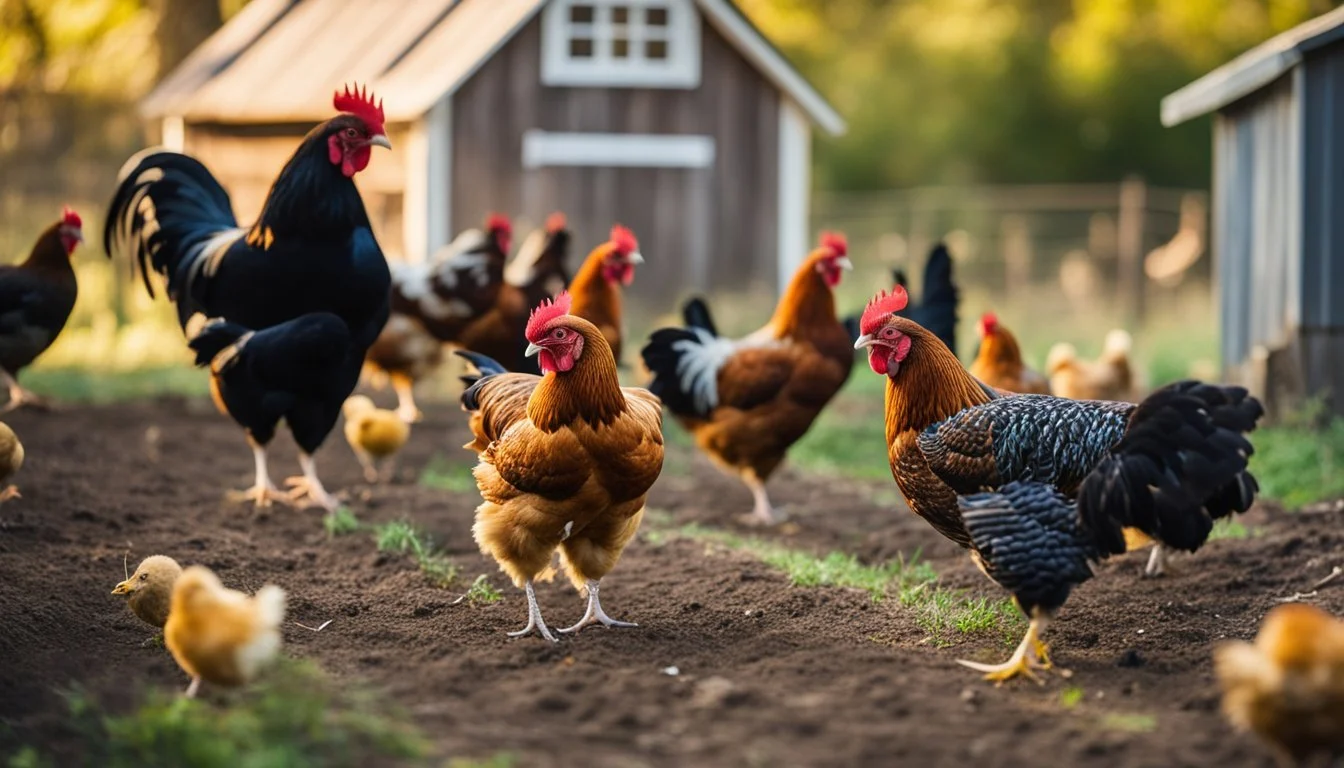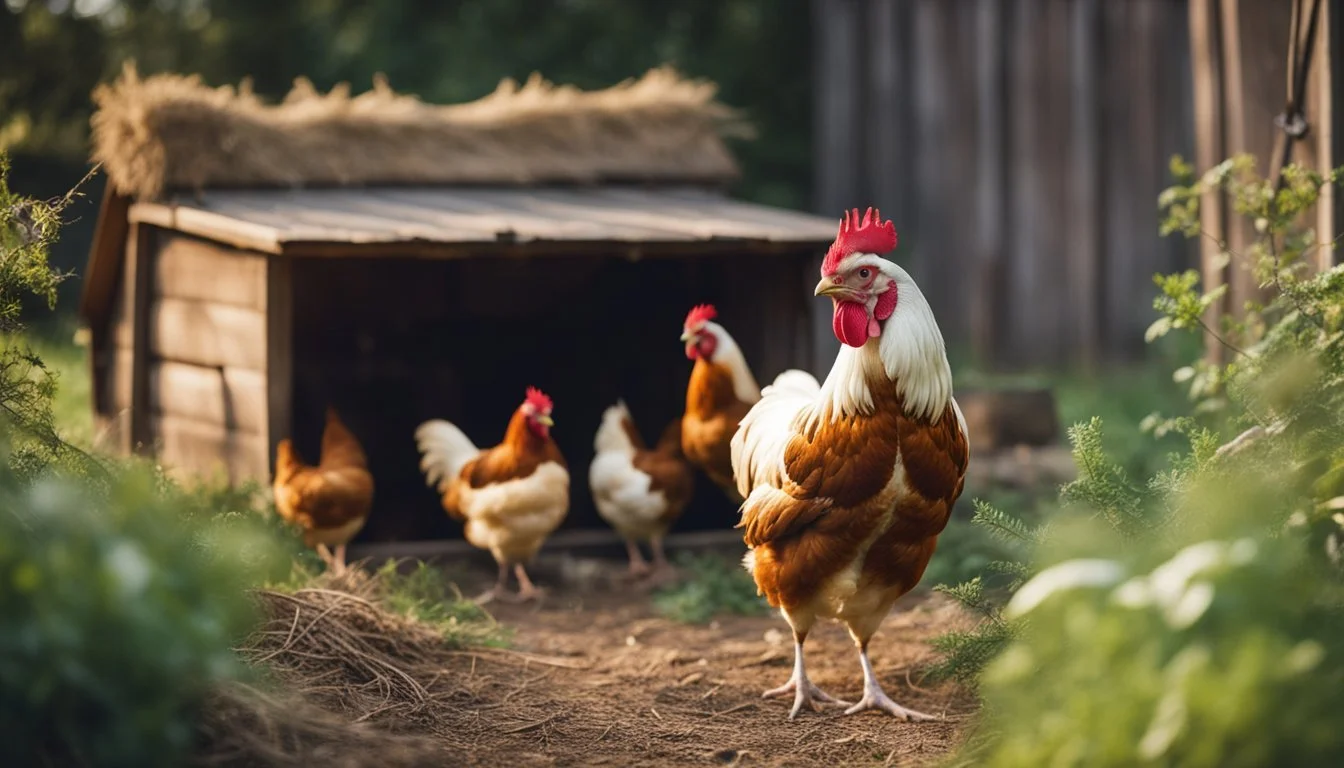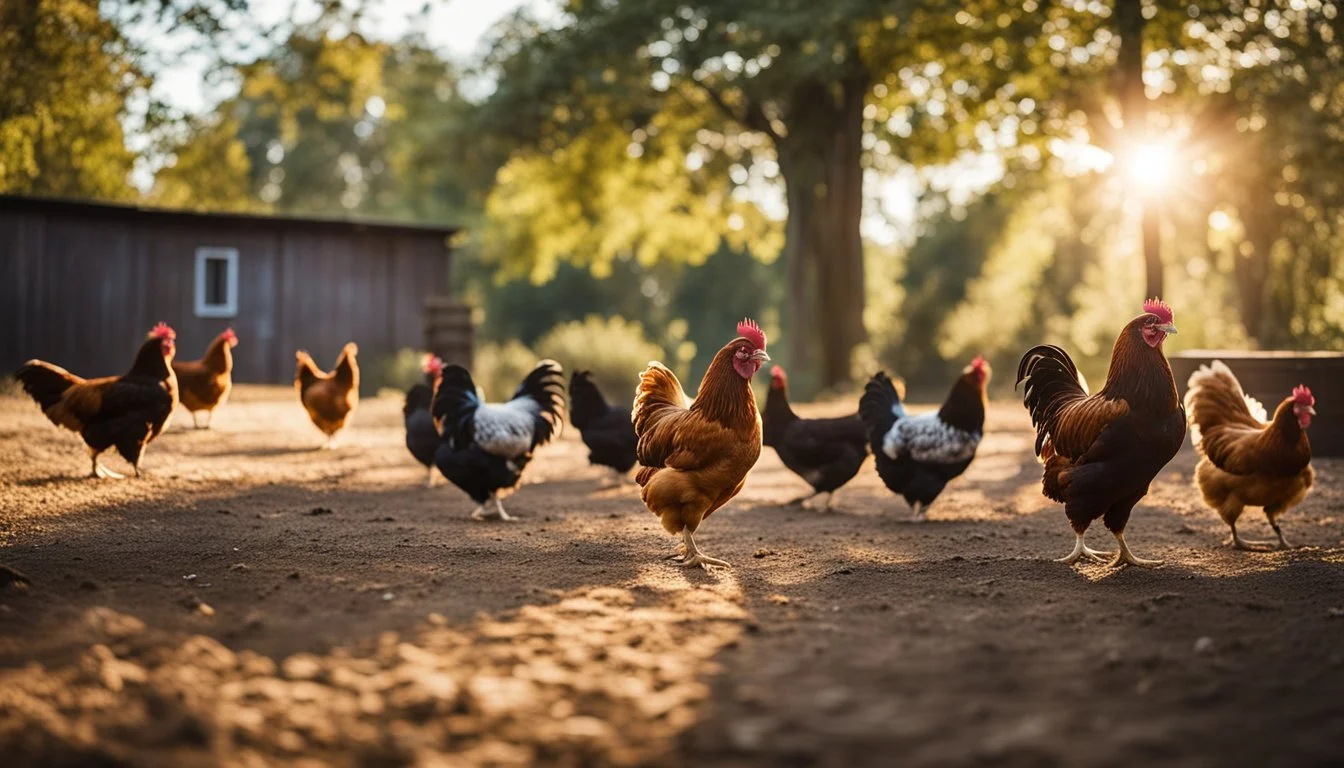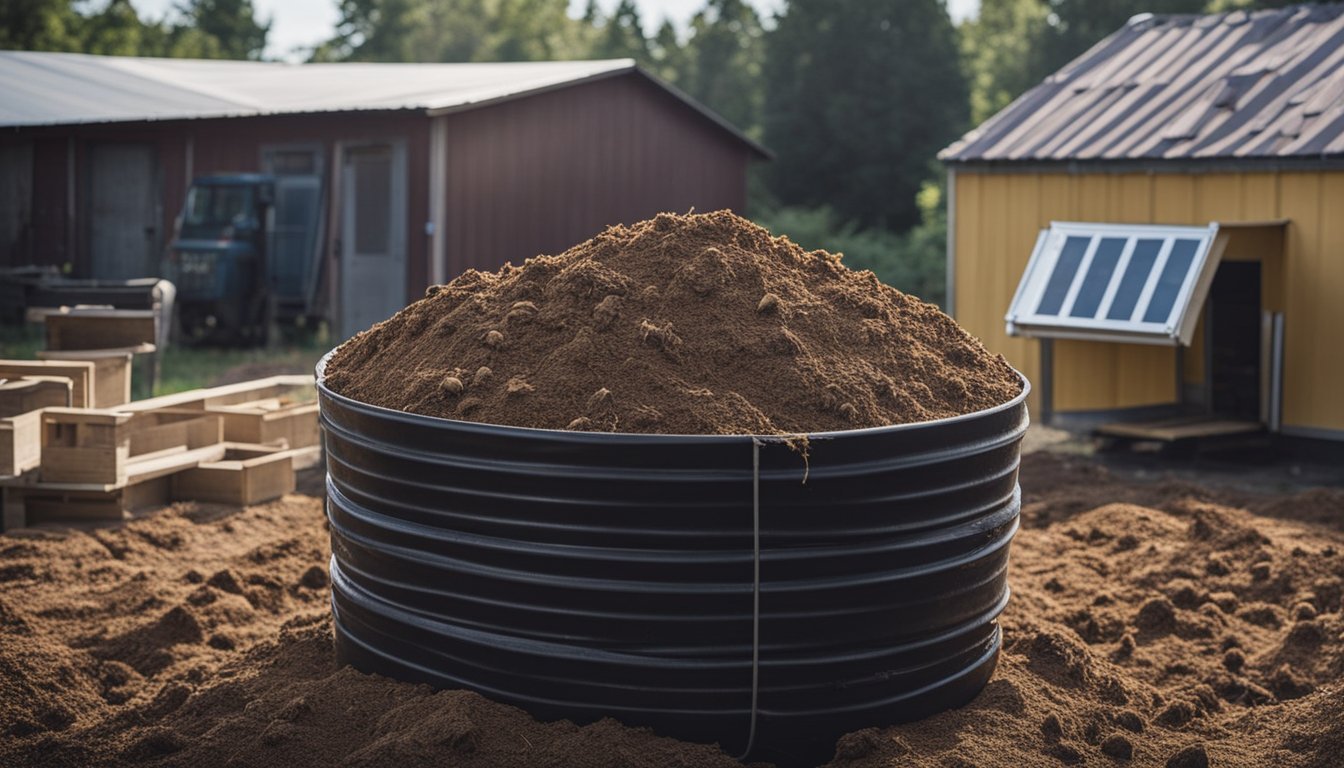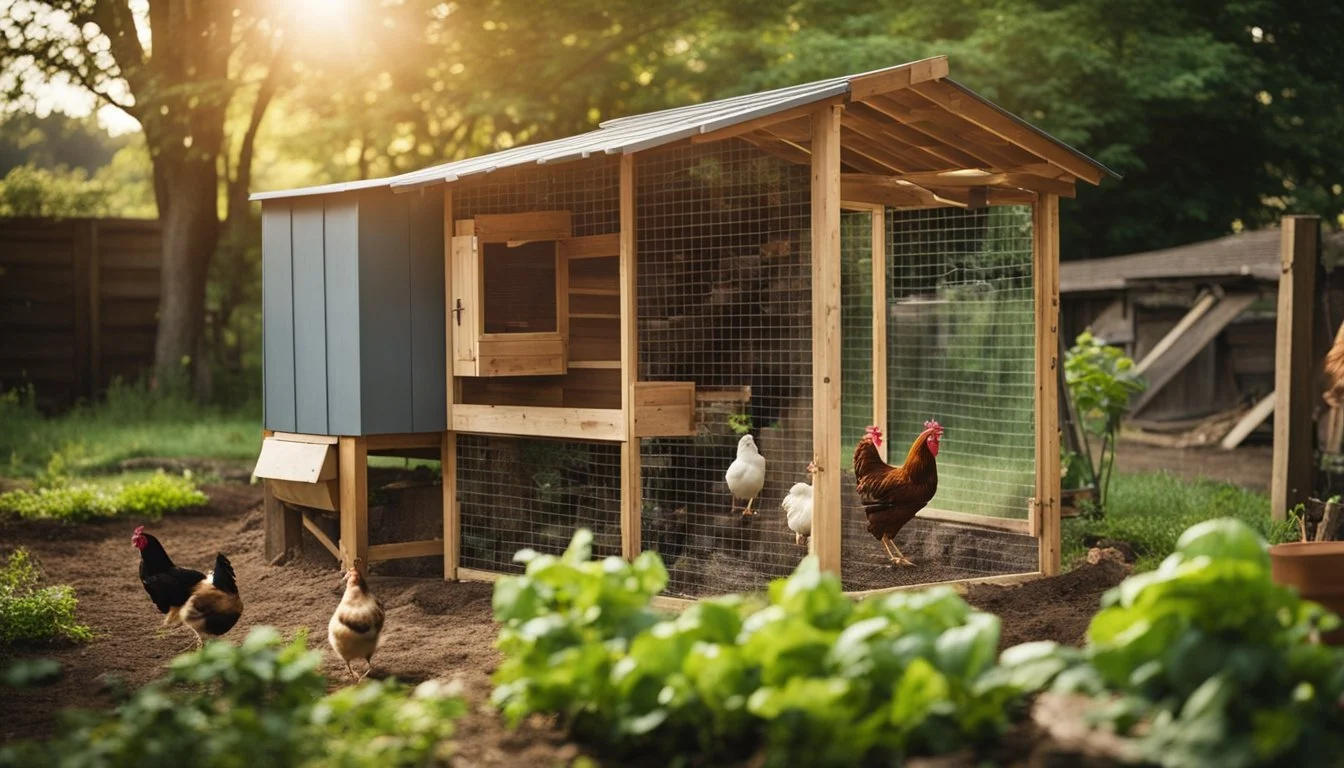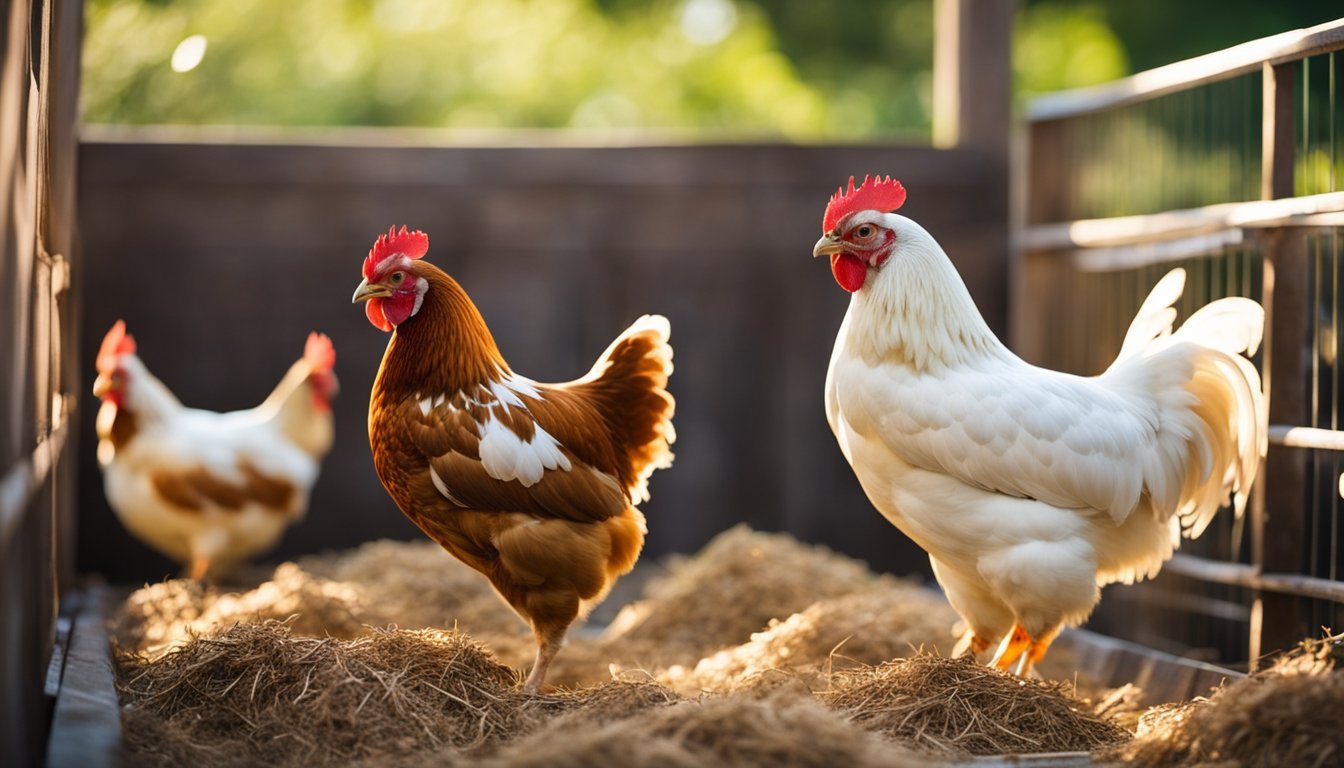8 Tips for Raising Chickens with Limited Resources
Practical Strategies for Success
Raising chickens can be a rewarding endeavor, especially for those looking to benefit from fresh eggs and sustainable living. However, the cost and resource requirements can seem daunting to new and experienced chicken owners alike. Learning how to manage and optimize limited resources can make raising chickens more accessible and affordable.
Chickens require daily food and clean water, along with adequate space to roam and a safe coop for shelter. By focusing on essential supplies and efficient practices, anyone can successfully raise chickens without overwhelming expenses.
1) Choose Hardy Breeds
Selecting durable chicken breeds is essential when resources are limited.
Opt for breeds known for their toughness in various climates. Buckeyes, for example, are highly resistant to cold due to their pea comb and absence of wattles. This makes them less susceptible to frostbite.
Breeds like Black Australorp and Wyandotte are great for both hot and cold environments.
The Sussex chicken is another excellent option. It offers both heat and cold tolerance and lays about 250 large brown eggs annually.
Welsummers are hardy and perform well in colder areas. Despite being slower to mature, they make excellent free-rangers and integrate well with other birds.
2) Build a Cost-Effective Coop
When building a chicken coop on a budget, start with planning and design. Allocate 2-3 square feet per chicken inside the coop and 8-10 square feet in an outdoor run. This ensures they have enough space to move comfortably.
Use pallets and reclaimed wood for the structure. Pallets provide a sturdy and cost-effective frame. Screwing a piece of wood to the roof and connecting pallet walls can create the basic shape of the coop.
For walls, 2×3 lumber offers a balance of strength and affordability. Exterior construction screws ensure durability. To save further, consider using beaded plywood panels for interior walls, cutting them with a jigsaw for precise fitting.
Windows can be covered with chicken wire to keep predators out while allowing ventilation. Ensure the door has a secure frame, filling gaps with additional chicken wire if needed. Reusing excess wood to build the door helps minimize costs.
By focusing on these materials and construction techniques, building a chicken coop can be both budget-friendly and effective in providing a safe environment for the flock.
3) Utilize Free-Range Feeding
Free-range feeding allows chickens to forage for their own food, reducing the need for purchased feed. Chickens will naturally scratch at the ground, finding insects, seeds, and plants to eat. This method supplements their diet while also providing enrichment.
Creating a safe foraging area is essential. Ensure the chickens have access to a secure outdoor space where predators are less likely to pose a threat. Natural barriers, like tall grass or bushes, can offer additional protection and cover.
Introduce chickens to free-range slowly, monitoring them closely at first. This helps them adjust to the new environment and establishes their foraging patterns. Train them to return to the coop at night to keep them safe from nocturnal predators.
Scatter scratch grains around the foraging area to encourage natural behaviors. This can keep chickens entertained and satisfy their scratching instincts. Additionally, hanging treat caddies filled with vegetable scraps can provide extra nutrition and interest.
Free-range feeding can lead to healthier chickens and a more sustainable feeding strategy. It is a practical solution for those with limited resources, allowing chickens to thrive while minimizing costs.
4) Compost Chicken Manure
Using chicken manure as compost can provide a valuable fertilizer for your garden.
To start, maintain an optimal carbon-to-nitrogen ratio. Chicken manure is high in nitrogen, so balance it with carbon-rich materials like leaves or straw. Aim for a 1:1 mix for effective decomposition.
Ensure the compost pile has adequate moisture. It should feel like a damp sponge, not too wet or dry. Turn the pile regularly to introduce oxygen, promoting aerobic decomposition.
Temperature is crucial. Compost piles should heat up to 130-150°F to kill pathogens and weed seeds. Monitor and adjust the pile if necessary.
Consider the deep litter method. In this approach, add layers of bedding to the chicken coop. Over time, this material composts directly under the chickens, reducing the need for an external compost bin.
Patience is key. Composting chicken manure typically takes six months to a year. Once it's dark and crumbly, it’s ready to use in the garden.
By following these guidelines, chicken manure can be turned into a nutrient-rich compost, benefiting soil health and plant growth.
5) DIY Chicken Feeders
DIY chicken feeders are an excellent way to save money and reduce waste in your chicken coop. Numerous materials can be repurposed to create effective feeders. PVC pipes, for example, are commonly used due to their durability and ease of adaptation.
One easy method involves using a plastic bucket. By cutting holes into the sides and inserting feeder ports, you create a rain-protected and efficient feeder. Ensure the feeding holes are directed downward to minimize spillage and wasted feed.
Another popular option is the tote bin feeder. By drilling holes into a plastic tote and inserting PVC pipes, you can create multiple feeding spots. This setup can be glued or strapped in place for stability.
For those who prefer a more traditional approach, trough-style feeders made from wood can serve many birds at once. Adding wire mesh over the top helps designate individual feeding zones and control feed distribution.
Lastly, an efficient and sustainable option includes using a plastic bottle. By cutting the bottle and positioning it to dispense feed automatically, you ensure your chickens are fed while reducing plastic waste.
These DIY options are cost-effective and functional, promoting a healthier and more efficient feeding routine for your chickens.
6) Collect Kitchen Scraps for Feed
Collecting kitchen scraps for chicken feed is a practical way to reduce waste and save money.
Chickens can enjoy various kitchen leftovers such as bread, rice, pasta, and cereal crumbs. These scraps provide a supplement to their diet, though they should not exceed 10% of the total feed.
It's essential to provide these scraps in moderation, ideally once a day. Serve them in small amounts that chickens can consume within 10-20 minutes.
Avoid giving chickens spoiled food or scraps with strong flavors, like onions or garlic. Such items can affect the taste of their eggs.
Maintaining a balance is crucial. While kitchen scraps can supplement their diet, ensure chickens have constant access to a complete chicken feed to meet their nutritional needs.
7) Use Rainwater for Drinking
Utilizing rainwater for chickens is an effective way to conserve resources. Rainwater is free from chemicals such as chlorine and fluoride, common in municipal water supplies. This natural source can be healthier for chickens.
Collecting rainwater can be simple. A basic setup includes placing a bucket under a downspout or runoff area. More advanced systems can be designed with barrels and taps for easier access.
Make sure to regularly clean your collection containers to prevent algae and bacteria buildup. Covering the containers when not in use can minimize contamination from debris or pests.
For larger flocks, integrating U-shaped tanks that hold several gallons can provide a few days' reserve water supply. Using chicken nipples can help keep the water source cleaner and reduce the risk of illness.
Always monitor the system. Ensure that the collected water is clear and free of contaminants. Regular maintenance will help ensure the health and safety of your chickens. Rainwater harvesting not only conserves water but also reduces your overall expenses.
8) Repurpose Old Materials
Repurposing old materials can save money and reduce environmental impact.
Used PVC pipes can be turned into feeders or watering systems for chickens. Plastic buckets can serve similar purposes, providing cost-effective and functional solutions.
Wood scraps and leftover building materials can be used to construct the coop's framework. Items like hickory flooring or excess 2x4s can find new life in coop construction.
Metal materials, such as galvanized roofing or old tin sheets, are ideal for the roof of the coop. These materials offer durability and weather protection.
Reinforcing vulnerable areas with sturdy mesh fencing, like predator-proof mesh, ensures the coop's safety. Avoid using weaker materials like chicken wire which might not be sufficient to deter predators like foxes and rats.
Even furniture pieces can be repurposed. Old dressers or cabinets can be transformed into nesting boxes. Creativity is key, and nearly any sturdy material can find a place in your coop’s design.
Reusing materials not only cuts costs but also offers a unique charm to the coop. It's all about using what you have at hand efficiently. This approach benefits both the chickens and the environment.
Planning Your Chicken Coop
Designing a chicken coop efficiently with limited resources involves careful attention to location and the use of essential features and materials to ensure a healthy environment for the chickens.
Choosing the Right Location
Selecting the proper location for a chicken coop is crucial. It should be situated in a spot with good drainage to prevent water accumulation, which can cause dampness and disease. Access to sunlight is essential as it helps maintain the chickens' health and egg productivity. Positioning the coop to face away from prevailing winds can improve insulation and provide better weather protection.
Other considerations include proximity to the house for convenience and a far enough distance to mitigate odors. Fencing the area can prevent predators and keep the chickens safe. Adequate space should be allotted to avoid overcrowding, which can lead to stress and health issues.
Essential Features and Materials
A well-planned chicken coop should incorporate specific features to foster a conducive environment for the flock. Ensuring proper ventilation is key; installing windows or vents will help maintain air quality and temperature. Nesting boxes and roosting bars are essential for egg-laying and sleeping routines, respectively, and should be planned based on the flock size.
When it comes to building materials, using sturdy but affordable options like plywood, recycled pallets, and wire mesh can keep costs down. The floor should be easy to clean, and adding bedding materials like straw or wood shavings can enhance comfort. Security measures, such as strong latches and predator-proof materials, should not be overlooked to protect the chickens from potential threats.
Feeding Chickens Efficiently
Feeding chickens on a budget requires strategic choices, including selecting affordable feed options and utilizing kitchen scraps to supplement nutrition.
Affordable Feeding Options
Opting for cost-effective feeds can significantly ease the financial burden of raising chickens. A good approach is to buy grains such as rice, barley, wheat, and oats in bulk. These grains provide essential carbohydrates and can be blended slightly to maintain a textured feed rather than a powder.
Consider grower feed for young chickens. Grower feed typically contains 14-18% protein, which supports their development from 6 to 20 weeks of age. For laying hens, layer feed with 16-18% protein helps maintain egg production while being affordable.
Creating a diet plan that combines these grains with appropriate commercial feeds ensures balanced nutrition.
Supplemental Nutrition from Scraps
Kitchen scraps can be a valuable addition to a chicken's diet, providing essential nutrients without extra cost. Suitable scraps include vegetable peels, leftover cooked grains, and fruit bits. These scraps offer variety and can supply additional vitamins and minerals.
However, it's critical to avoid feeding chickens certain items like raw potatoes, onions, or citrus peels, as these can be harmful.
Incorporating small amounts of protein-rich leftovers, such as cooked eggs or meat, can also be beneficial, especially during molting periods. Utilizing scraps effectively reduces waste and lowers feeding costs, providing a sustainable feeding strategy.
Health and Hygiene Management
To ensure the well-being of chickens, focus on regular health monitoring and maintaining a clean living environment. Proper sanitation and routine checks can prevent illnesses and promote a healthier flock.
Basic Health Monitoring Tips
Health monitoring begins with observing chickens for signs of illness. Key symptoms to watch for include labored breathing, watery eyes, and reduced appetite. Consistent checks help in the early detection of diseases, allowing for quicker intervention.
Daily observation is crucial. Look for changes in behavior or physical appearance. Abnormal droppings, wheezing, or lethargy should prompt immediate action. Wearing protective clothing such as gloves and masks when handling sick birds is also recommended.
Routine health checks can include palpating for any unusual lumps or swelling. Additionally, ensuring birds are properly nourished with the right feed helps maintain their immune systems. Monitoring their environment, including temperature and feed intake, is essential.
Maintaining a Clean Environment
Cleanliness in the coop plays a significant role in chicken health. Regularly remove soiled bedding and droppings to minimize the risk of disease. Fresh, clean bedding should replace dirty materials to create a comfortable living space.
Isolation of sick chickens is necessary to prevent the spread of contagious diseases. Use a separate pen and equipment for any ill birds. Sanitize these areas frequently with appropriate cleaning agents to maintain a safe environment.
Proper ventilation in the coop helps prevent respiratory issues. Ensuring feeders and waterers are clean daily reduces the risk of bacterial growth. Lastly, investing in quality feeding equipment can limit waste and prevent accidents. Maintaining a clean coop ultimately supports the overall health of the poultry.

